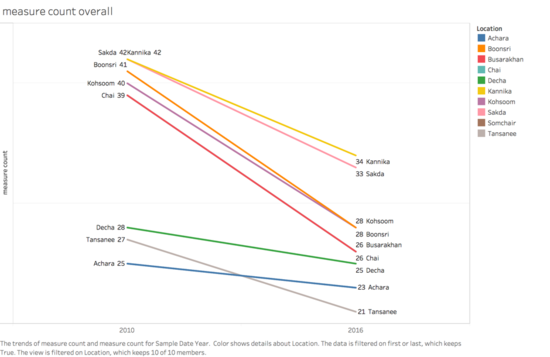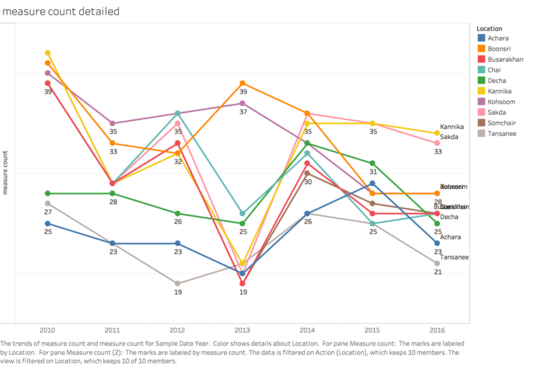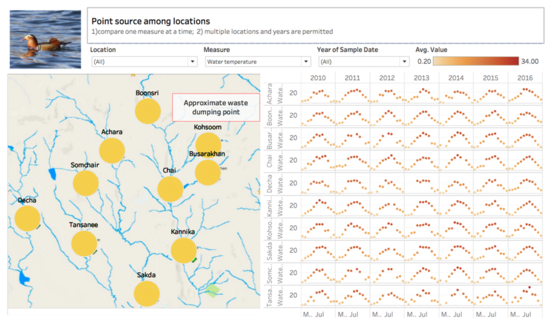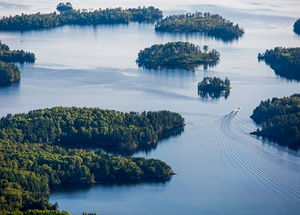Difference between revisions of "ISS608 2017-18 T3 G2 Assign ChenYanchong Visualization"
Ycchen.2017 (talk | contribs) |
Ycchen.2017 (talk | contribs) |
||
| Line 55: | Line 55: | ||
'''Kannika and Sakda are quite clean area''' | '''Kannika and Sakda are quite clean area''' | ||
|| | || | ||
| − | Macrozoobenthos are the indicator of nice water quality, compared to the other locations, the detected number of macrozoobenthos is higher, even in year 2014, after year 2013. | + | * Macrozoobenthos are the indicator of nice water quality, compared to the other locations, the detected number of macrozoobenthos is higher, even in year 2014, after year 2013. |
|- | |- | ||
| Line 61: | Line 61: | ||
'''Somchair and Sakda are quite similar area''' | '''Somchair and Sakda are quite similar area''' | ||
|| | || | ||
| − | Evidence can be found while point sourcing the measures, especially Barium, Boron and Chlorodine, the distributions are more or less the same among these areas. | + | * Evidence can be found while point sourcing the measures, especially Barium, Boron and Chlorodine, the distributions are more or less the same among these areas. |
|- | |- | ||
| Line 84: | Line 84: | ||
'''Water temperature will affect the other chemicals''' | '''Water temperature will affect the other chemicals''' | ||
|| | || | ||
| − | As mentioned in above section, water temperature reaches its highest point in the preserve, meanwhile, total dissolved oxygen reaches its lowest in all the locations. | + | * As mentioned in above section, water temperature reaches its highest point in the preserve, meanwhile, total dissolved oxygen reaches its lowest in all the locations. |
|- | |- | ||
| Line 99: | Line 99: | ||
=Question 2= | =Question 2= | ||
'''What anomalies do you find in the waterway samples dataset? How do these affect your analysis of potential problems to the environment? Is the Hydrology Department collecting sufficient data to understand the comprehensive situation across the Preserve? What changes would you propose to make in the sampling approach to best understand the situation? '''<br/><br/> | '''What anomalies do you find in the waterway samples dataset? How do these affect your analysis of potential problems to the environment? Is the Hydrology Department collecting sufficient data to understand the comprehensive situation across the Preserve? What changes would you propose to make in the sampling approach to best understand the situation? '''<br/><br/> | ||
| − | <div style="margin:0px; padding: 2px | + | <div style="margin:0px; padding: 2px; font-family: Arial; border-radius: 1px; text-align:left"> |
{| class="wikitable" style="background-color:#FFFFFF;" width="100%" | {| class="wikitable" style="background-color:#FFFFFF;" width="100%" | ||
|- | |- | ||
| | | | ||
| − | Anomalies | + | '''Anomalies ''' |
|| | || | ||
| − | Effect | + | '''Effect''' |
|- | |- | ||
| Line 135: | Line 135: | ||
|} | |} | ||
</div> | </div> | ||
| − | To conclude, the Hydrology Department offers sufficient volume of data for analysis. But there are some issues existing, which cause ambiguity. The data quality should be improved for better understanding the comprehensive situation across the preserve. <br/></ | + | To conclude, the Hydrology Department offers sufficient volume of data for analysis. But there are some issues existing, which cause ambiguity. The data quality should be improved for better understanding the comprehensive situation across the preserve. <br/><br/> |
Personal suggestions to improve the sampling strategies:<br/> | Personal suggestions to improve the sampling strategies:<br/> | ||
* 1. Samples should be taken at the same day from the sampling positions | * 1. Samples should be taken at the same day from the sampling positions | ||
| Line 145: | Line 145: | ||
=Question 3= | =Question 3= | ||
'''After reviewing the data, do any of your findings cause particular concern for the Pipit or other wildlife? Would you suggest any changes in the sampling strategy to better understand the waterways situation in the Preserve? '''<br/><br/> | '''After reviewing the data, do any of your findings cause particular concern for the Pipit or other wildlife? Would you suggest any changes in the sampling strategy to better understand the waterways situation in the Preserve? '''<br/><br/> | ||
| − | According to Wikipedia, Pipits are associated with some kind of grassland, from sea-level to alpine tundra. The diet of the pipits is dominated by small invertebrates. Insects are the most important prey items, the composition of their diet apparently reflecting the abundance of their prey in the location (and varying with the season). | + | According to Wikipedia, Pipits are associated with some kind of grassland, from sea-level to alpine tundra. The diet of the pipits is dominated by small invertebrates. Insects are the most important prey items, the composition of their diet apparently reflecting the abundance of their prey in the location (and varying with the season).[https://en.wikipedia.org/wiki/Pipit]<br/> |
| + | Atrazine and p,p-DDT were founded in the water, they are commonly used herbicide. They could penetrate from soil to water through groundwater circulation. Surprisingly, they were found in the waterways sensor readings, there is a high probability that they were being used to weed, which may affect the grass within the preserve, hence, the habitat of the pipits was destroyed. Moreover, pipit's diet is mainly from intersects, whilst grass is the major habitat for breeding intersects. As a result, the number of pipits will be affected in the corresponding years when herbicide was found. If the records regarding pipit's number could be provided, this assumption could be verified.<br/><br/> | ||
| + | Improvements for sampling strategy should made to better understanding the waterways situation:<br/> | ||
| + | Sample data are taken from 4 different streams in the preserve, shown as following, among all of the 10 locations, only 2 of them are located on the tributary, namely, Kohsoom and Busarakhan. Though these two locations are near the approximate waste dumping point, they have good reasons to take more samples from the suspicious area, however, comparing water from tributary with water from the main stream is unfair as water in rivers are sensitive to locations in a sequential order, the upstream will affect the downstream, the tributary will affect the main stream, due to the liquidity of water.<br/> | ||
| + | To better understanding the waterways situation within the preserve, more sampling points are needed, those points should locate at the tributary of the rests of the river streams, hence, comparisons across rivers could be performed within tributary as well as within main stream. | ||
Revision as of 20:55, 8 July 2018
The final visualisation story board is available through Chen Yanchong's Tableau Public
The task of the visualisation is to answer the following 3 questions.
Question 1
Characterize the past and most recent situation with respect to chemical contamination in the Boonsong Lekagul waterways. Do you see any trends of possible interest in this investigation?
If the overall tendency (all showing upward or all showing downward trend) is the same across the 10 locations, we can assume that the changes along with years are caused by natural effect instead of human intervention.
Slope chart is a good practice to show the difference between the start point and the end point.

From above slope chart, the water taken from the 10 locations seems cleaner in the year 2016 than it in the year 2010. Compared to the obvious decrease, Decha and Tansanee decrease slower than the rest of the locations.
Does the water composition decrease year by year? Taking a closer look at how the water composition changes year by year.

Above line chart reveals that in year 2013, the number of compositions decrease till the lowest point in 7 of the 10 locations, but not in Kohsoom, Boonsri and Tansanee. After year 2013, the trend reversed a bit, the composition of water chemicals in the other 8 places start to increase whilst Kohsoom and Boonsri show contrast trend.
Is it because these three places are polluted by human intervention? From the background information, the furniture company Kasios was established in year 2013, furthermore, from the map of the preserve, Kohsoom and Boonsri are the two locations which are the nearest ones to the suspicious waste dumping point, however, Tasanee is further away from the approximate waste dumping point.
Point source[1]might be helpful to clarify the mystery.

The purpose of the point source is to compare the differences of one certain measures among the locations during the same period of time. To perform the point source, multiple locations and years are allowed to select at a time, however, only one measure can be picked out at the same time.
Above picture shows how the water temperature changes in the past 6 years among the 10 positions. Obviously, water temperature shows the same trends across the 10 locations, it shows a bell curve and always reaches its highest in July. There are some empty area in the graph, indicates that water temperature is not taken.
After examining all the measures in the processed data set, several conclusions are as attached :
|
Conclusions |
Evidences |
|
Kannika and Sakda are quite clean area |
|
|
Somchair and Sakda are quite similar area |
|
|
The density of chemicals in downstream will not be affected by the upstream, except for cumulative chemicals |
|
|
Boonsri, Kohsoom are similar |
|
|
Water temperature will affect the other chemicals |
|
|
There could be another waste dumping point near Tansanee |
|
Question 2
What anomalies do you find in the waterway samples dataset? How do these affect your analysis of potential problems to the environment? Is the Hydrology Department collecting sufficient data to understand the comprehensive situation across the Preserve? What changes would you propose to make in the sampling approach to best understand the situation?
|
Anomalies |
Effect |
|
The measures are not consistent in different years. E.g. Auminium is not measured in other years except for year 2010 |
the comparison against years could be inaccurate |
|
The chemicals measured by the water sensors are not the same across the locations. E.g. 17 measures were detected in one location while the other locations might only take measures with a number varies from 10 to 35 during the same time period |
it is better if the sample data could detect same measures in different locations, hence, when one measure does not exist, could mark as 0. If that measure is not detected, could mark as null. |
|
The number of records are not the same in different locations even for the same measure which the record is taken at the same day. E.g. chlorides was taken 3 times in Achara at one day, but in Boonsri it was only taken once |
sometimes the water temperature and even stream speed might draw a huge effect on the density of the measures, if one measure was taken twice a day, the other measures should be taken twice no matter which location it was taken from |
|
The sampling date is not consistency, for example, on 1 Jan 2015, Achara and other 8 locations have sensor readings but for Boonsri and Decha sensor readings are taken on 8 Jan 2015 |
such issue limits the analysis to drill down to a lower granularity (date level), moreover the accuracy could be affected |
To conclude, the Hydrology Department offers sufficient volume of data for analysis. But there are some issues existing, which cause ambiguity. The data quality should be improved for better understanding the comprehensive situation across the preserve.
Personal suggestions to improve the sampling strategies:
- 1. Samples should be taken at the same day from the sampling positions
- 2. If one location measures water three times a day, the other locations should have 3 records for each chemicals per day
- 3. When arrange one sampling investigation, should take the same measures across the preserve, hence, if one chemical does not appear in the investigated locations, the value column should be zero, if one chemical is not measured during that investigation, it will not appear on the measure list across the locations
Question 3
After reviewing the data, do any of your findings cause particular concern for the Pipit or other wildlife? Would you suggest any changes in the sampling strategy to better understand the waterways situation in the Preserve?
According to Wikipedia, Pipits are associated with some kind of grassland, from sea-level to alpine tundra. The diet of the pipits is dominated by small invertebrates. Insects are the most important prey items, the composition of their diet apparently reflecting the abundance of their prey in the location (and varying with the season).[2]
Atrazine and p,p-DDT were founded in the water, they are commonly used herbicide. They could penetrate from soil to water through groundwater circulation. Surprisingly, they were found in the waterways sensor readings, there is a high probability that they were being used to weed, which may affect the grass within the preserve, hence, the habitat of the pipits was destroyed. Moreover, pipit's diet is mainly from intersects, whilst grass is the major habitat for breeding intersects. As a result, the number of pipits will be affected in the corresponding years when herbicide was found. If the records regarding pipit's number could be provided, this assumption could be verified.
Improvements for sampling strategy should made to better understanding the waterways situation:
Sample data are taken from 4 different streams in the preserve, shown as following, among all of the 10 locations, only 2 of them are located on the tributary, namely, Kohsoom and Busarakhan. Though these two locations are near the approximate waste dumping point, they have good reasons to take more samples from the suspicious area, however, comparing water from tributary with water from the main stream is unfair as water in rivers are sensitive to locations in a sequential order, the upstream will affect the downstream, the tributary will affect the main stream, due to the liquidity of water.
To better understanding the waterways situation within the preserve, more sampling points are needed, those points should locate at the tributary of the rests of the river streams, hence, comparisons across rivers could be performed within tributary as well as within main stream.
